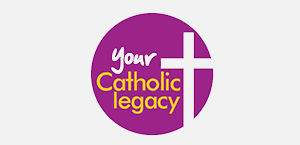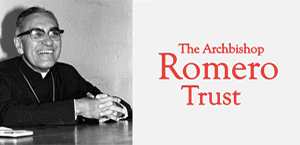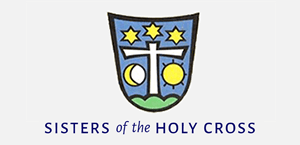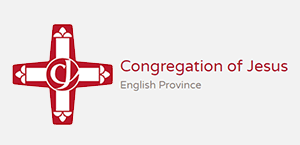Gospel in Art: And at his gate there lay a poor man called Lazarus
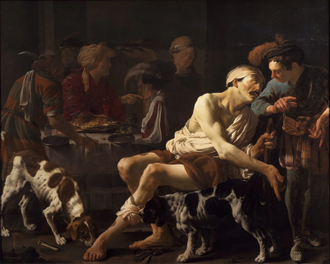
The Rich Man and the Poor Lazarus, by Hendrick ter Brugghen, 1625 © Centraal Museum, Utrecht
Source: Christian Art
Gospel of 29 February 2024
Luke 16:19-31
Jesus said to the Pharisees: 'There was a rich man who used to dress in purple and fine linen and feast magnificently every day. And at his gate there lay a poor man called Lazarus, covered with sores, who longed to fill himself with the scraps that fell from the rich man's table. Dogs even came and licked his sores. Now the poor man died and was carried away by the angels to the bosom of Abraham. The rich man also died and was buried.
'In his torment in Hades he looked up and saw Abraham a long way off with Lazarus in his bosom. So he cried out, "Father Abraham, pity me and send Lazarus to dip the tip of his finger in water and cool my tongue, for I am in agony in these flames." "My son," Abraham replied "remember that during your life good things came your way, just as bad things came the way of Lazarus. Now he is being comforted here while you are in agony. But that is not all: between us and you a great gulf has been fixed, to stop anyone, if he wanted to, crossing from our side to yours, and to stop any crossing from your side to ours."
'The rich man replied, "Father, I beg you then to send Lazarus to my father's house, since I have five brothers, to give them warning so that they do not come to this place of torment too." "They have Moses and the prophets," said Abraham "let them listen to them." "Ah no, father Abraham," said the rich man "but if someone comes to them from the dead, they will repent." Then Abraham said to him, "If they will not listen either to Moses or to the prophets, they will not be convinced even if someone should rise from the dead."'
Reflection on the painting
Hendrick Jansz ter Brugghen was a Dutch painter of genre scenes and religious subjects. He was one of the main members of the group of Dutch followers of Caravaggio - the so-called Utrecht Caravaggisti. Caravaggio's influence is clearly visible in the use of strong 'chiaroscuro' (dark/light) for the figures. Also Caravaggio used everyday people that he would literally take from the street and ask to sit for him as models; he then painted them realistically, just as they were. Our painting shows these same realistic and highly personal characteristics of the figures.
The main protagonist, who is lit in the foreground, is Lazarus. He is the central character of our story today. He is begging one of the master's servants to give him some food. He's had enough of just living off the crumbs from the table. The dogs are licking his wounds. The left dog is staring at us. They are hunting dogs, as would befit a wealthy man, and the painter appears to have taken delight in rendering the animals' well-brushed, spotted fur.
The scene is set like a theatrical stage. At the back, the rich man is entertaining a guest. He is dressed in a silk tunic, dyed with expensive purple in accordance with the story, and his table is covered in fine linen and bears a still life consisting of a large fish on a metal dish, a plate with juicy green olives, a bread roll, a small carafe, and two more pewter plates. The rich man holds a wine-filled flute glass while instructing an approaching maid.
On the far right, a lavishly dressed man-servant wearing a feathered cap is trying to move the ungainly beggar away from his master's doorstep. The servant is not mentioned in the parable, but is often included in visual representations to accentuate the rich man's dismissive attitude toward the poor.
Martin Luther King preached on this parable in 1968, a few weeks before his assassination. Dr. King said:
"… Because our expressways carry us from the ghetto, we don't see the poor. … Jesus told a parable one day, and he reminded us that a man went to hell because he didn't see the poor. His name was Dives. He was a rich man. And there was a man by the name of Lazarus who was a poor man, but not only was he poor, he was sick. Sores were all over his body, and he was so weak that he could hardly move. But he managed to get to the gate of Dives every day, wanting just to have the crumbs that would fall from his table. And Dives did nothing about it. And the parable ends saying, 'Dives went to hell, and there was a fixed gulf now between Lazarus and Dives.'
There is nothing in that parable that said Dives went to hell because he was rich. Jesus never made a universal indictment against all wealth. … Dives didn't realise that his wealth was his opportunity. It was his opportunity to bridge the gulf that separated him from his brother Lazarus. Dives went to hell because he passed by Lazarus every day and he never really saw him. He went to hell not because he was rich, but because he allowed his brother to become invisible…"
LINKS
Gospel in Art: https://christian.art/
Today's Reflection: https://christian.art/daily-gospel-reading/luke-16-19-31-2024/









